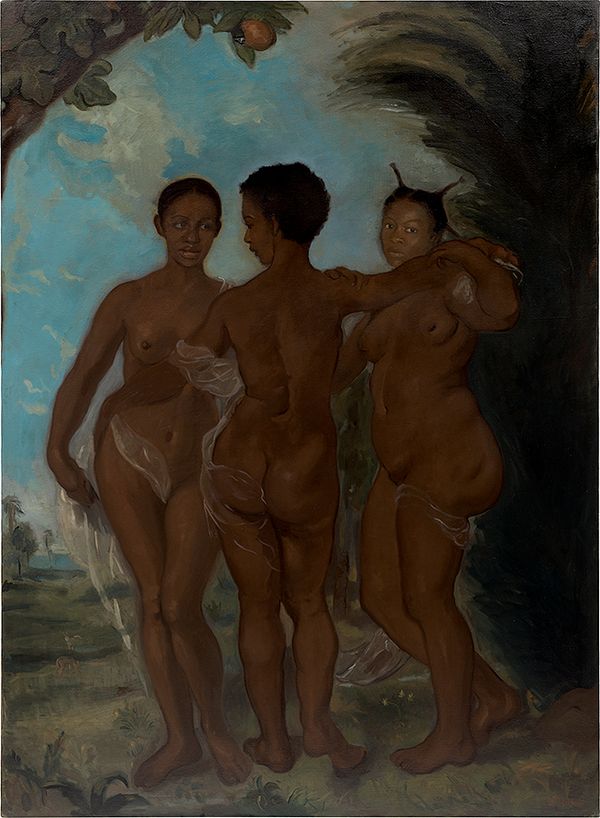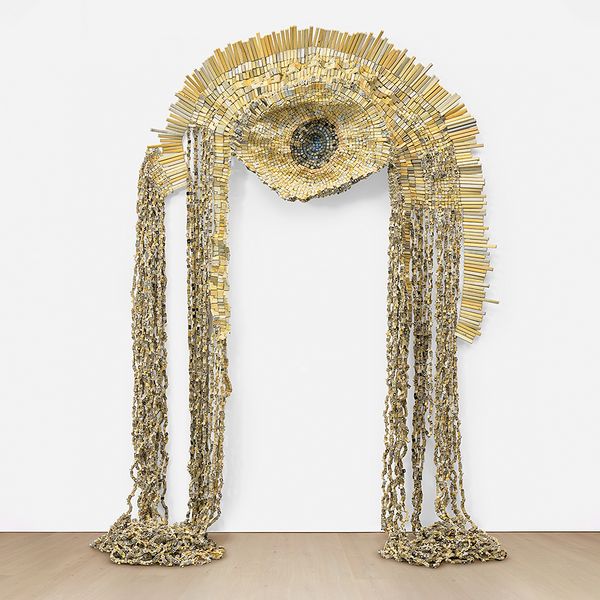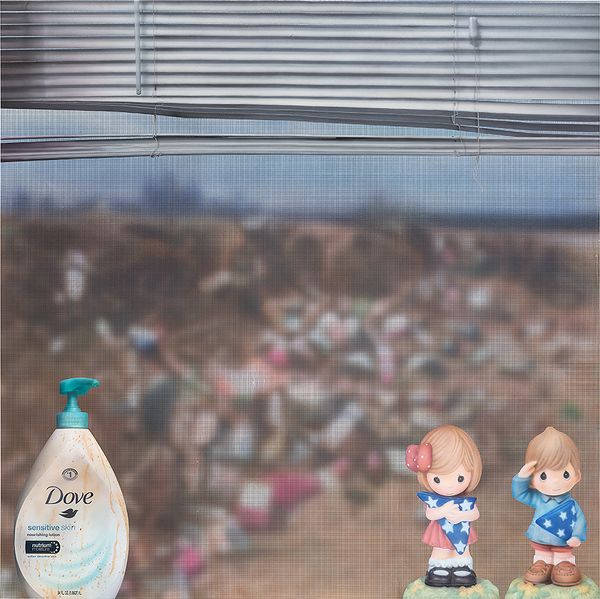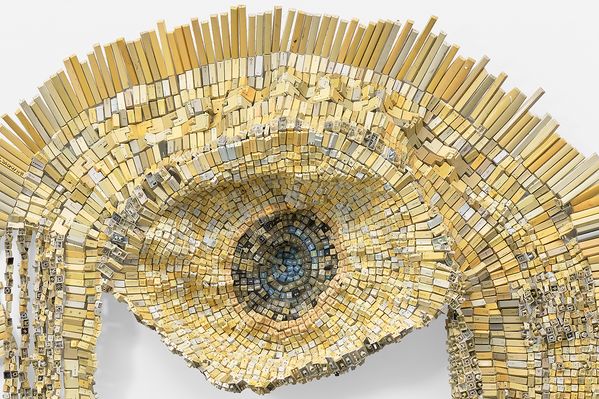Moffat Takadiwa, Judging by Language (detail), 2017. 20th Century to Now, London.
From the earliest, even prehistoric days of human migration, we’ve felt compelled to document and express our experiences through creative acts. It’s been no different in recent history, yet as cultural and political boundaries became more fully conceived in the modern era, that experience became much more complex. Further considering the totalizing nature of today’s socio-political order over physical boundaries, the fluidity with which culture moves and develops is a uniquely contemporary result of speed and connectivity.
For artists who have lived with these experiences, the complexities lead to many poignant questions: How does an artist working today maintain their personal authenticity after migrating to communities that seem to insist on their assimilation? With the exchange of art and ideas increasingly accessible, how can artists working within marginalized communities share compelling and probing criticisms with the art world and global culture at large?
These questions and many others are addressed in the charged and poignant works of several artists in our 20th Century to Now London Auction. Each a young artist having been raised in the age of the internet, they engage broadly with ideas around heritage, migration, and subsequently, cultural representation.

Sahara Longe, Three Graces, 2021. 20th Century to Now, London.
These notions can be explored through a multitude of creative avenues and artistic practices. For example, some artists engage with ideas around cultural representation by looking to the past, either to one’s own culture or to another. Sierra Leonean-British figurative painter Sahara Longe offers a skillful and compelling take on this approach, creating paintings that recall the resplendent and allegorical Renaissance and Baroque styles, but reimagined to include Black figures in a contemporary setting. What is perhaps most striking about Longe’s practice is the virtuosic skill with which she appropriates a traditional European technique. It’s possible to view this aspect of her work as a challenge to the very idea of cultural appropriation, through her use of a style which, in its own era, distinctly precluded Black representation.
Initially taken as a young artist with the work of Rubens, Velasquez, and Gaugin, Longe trained diligently at the Charles H. Cecil Studios in Florence where she learned classical traditions of oil painting. She later recounted the rigor of the program, recalling that she was only able to use five colors for two years as she acquired the technical precision that pervades her work today. As she told British Vogue, the program was “tough, and probably a bit weird, but I loved the discipline and the complete madness of the whole thing. People would leave all the time as it was quite hard, but I just love that it really teaches you how to paint.” Upon graduation, she spent time in Sierra-Leone before settling with her parents in England as the pandemic struck. It was then, after feeling unfulfilled by traditional portraiture commissions, that she began exploring the rich use of color that is so characteristic of her work today.
Her painting Three Graces consciously evokes Rubens, whose Three Graces she carefully studied in her process before using photographs of friends and her mother to model her subjects. This presents a uniquely rich set of associations through time and across cultures. By setting Black figures so well-known to her in this context, Longe perhaps reclaims the Old Master tradition for which she has such affection, offering a space of ownership of that tradition to her own culture and community. As the artist says, “The subject matter of the Three Graces is all about idealized beauty — so I wanted to see my own version.”

Cinga Samson, Ubuhle Beenkanyezi, 2018. 20th Century to Now, London.
A similarity can be felt between Longe’s work and that of South African artist Cinga Samson. Samson’s work clearly belongs to the tradition of painterly figuration and engages with both European and African modes of portraiture and landscape. While the artist has noted the profound influence of Western artists on his work, including Alberto Giacometti, Paul Gaugin, Francis Bacon, and Louise Bourgeois, what ultimately grounds his practice is the preservation of the dignity of his heritage and its collective identity. Though this preservation is central to his practice, Samson aims to propel culture forward, as the artist remarks, “I want to push into the future, not be marginalized under the politics of this moment [...] I don’t want to be an artist that feeds Western fantasies about what Africa is.”

Moffat Takadiwa, Judging by Language, 2017. 20th Century to Now, London.
Other contemporary artists working today employ a range of materials to query issues around global culture in our post-colonial moment. Zimbabwean artist Moffat Takadiwa’s provocatively titled assemblage work Judging by Language is composed of discarded computer keys and plastic cords. The work is characteristic of Takadiwa’s conceptual and intricate practice, which makes use of discarded materials and draws on themes of spirituality, colonialism, cultural identity, and environmental issues. Initially drawn to source materials from landfills due to the inaccessibility of other mediums, these everyday objects are given a new life as they are woven into organic forms that speak of Zimbabwean life.
I’ve always been interested in how to incorporate contradiction as a subtext.
—Sayre Gomez
This probing of waste and the contrast between our necessities and our daily vanities is also echoed in the seemingly obscured landfill that fills the background of Sayre Gomez’s Precious Moments. There’s a charged conversation present between components of the composition — a dirty bottle of an American consumer cosmetic product, gentle figurines of children holding the traditional folded American flag that is presented to families of the deceased at veteran memorial services, and the blurred imagery of a landfill seen through an interior window. These contradictions are something the Los Angeles based artist directly wishes to express, as he once remarked when asked what was most surprising to him about LA, “The disparity or gap between class stratification and the level of extreme wealth. It’s jarring to witness […] Venice Beach is interesting because when I first moved here, it was still kind of rough, and then it got extremely fancy. This juxtaposition of class and those collisions — I’ve always been interested in how to incorporate contradiction as a subtext.”

Sayre Gomez, Precious Moments, 2018. 20th Century to Now, London.
The theme of migration is also important to the artist. Gomez recalls, “When I was a little kid, my aunt gave me this book on Chicano muralists. When I moved into this building, I recognized a lot of those murals from when I was 12 years old. I ended up using one in a painting.” Los Angeles based artist Jaime Muñoz likewise explores concepts around migration and the divided culture of Southern California. His work engages with the idea of “Blood Memory,” which he explains “is a concept that relates to the inherent memory that we carry through our DNA. This concept interests me, as it pertains to colonial history as well as recent histories that are connected to traumatic experiences that we inherit through family.”
I identify as Chicano, but I don’t know if I identify my work as Chicano art, you know? But it does reflect my identity, especially the themes I’m exploring. Part of my intention of exploring those chronological themes is exploring the unseen aspects of the history we were brought up in.
— Jaime Muñoz

Jaime Muñoz, Madre, 2019. 20th Century to Now, London.
Muñoz’s work employs techniques that are adapted from his experience as a construction laborer to explore a variety of shared experiences among his community as well as themes of ancestral identity and the exploitive mechanization of the working-class experience. His work Madre embodies these themes — a grid-like structure, almost reminiscent of a blueprint, meets a carefully layered visual construction that is rich in allusion and spiritual and religious imagery.
Discover More from 20th Century to Now >
Recommended Reading
